Healthcare Performance Analysis: Australia vs. India (Report)
VerifiedAdded on 2022/09/06
|15
|3966
|34
Report
AI Summary
This report provides a comprehensive analysis of the healthcare systems of Australia and India, comparing their performance based on funding, governance arrangements, population health indicators (maternal mortality, infant mortality, and life expectancy), and health system performance indicators (low birth weight infants, diabetes, asthma, obesity, hypertension, and cancer). The analysis delves into the funding models, including the role of government and private insurance, and the percentage of GDP spent on healthcare. It examines the governance structures, highlighting the responsibilities of different levels of government. The report uses data to compare key health metrics, such as maternal and infant mortality rates and life expectancy, revealing significant differences in health outcomes. The analysis also considers the incidence of various health conditions, such as diabetes and asthma, to assess the overall health system performance. The report concludes by discussing the implications of the findings for health funders, policy makers, and service planning in both countries, drawing attention to the need for targeted interventions and improvements in specific areas. The report follows the assignment brief guidelines, providing a detailed comparison of the healthcare systems of both countries.
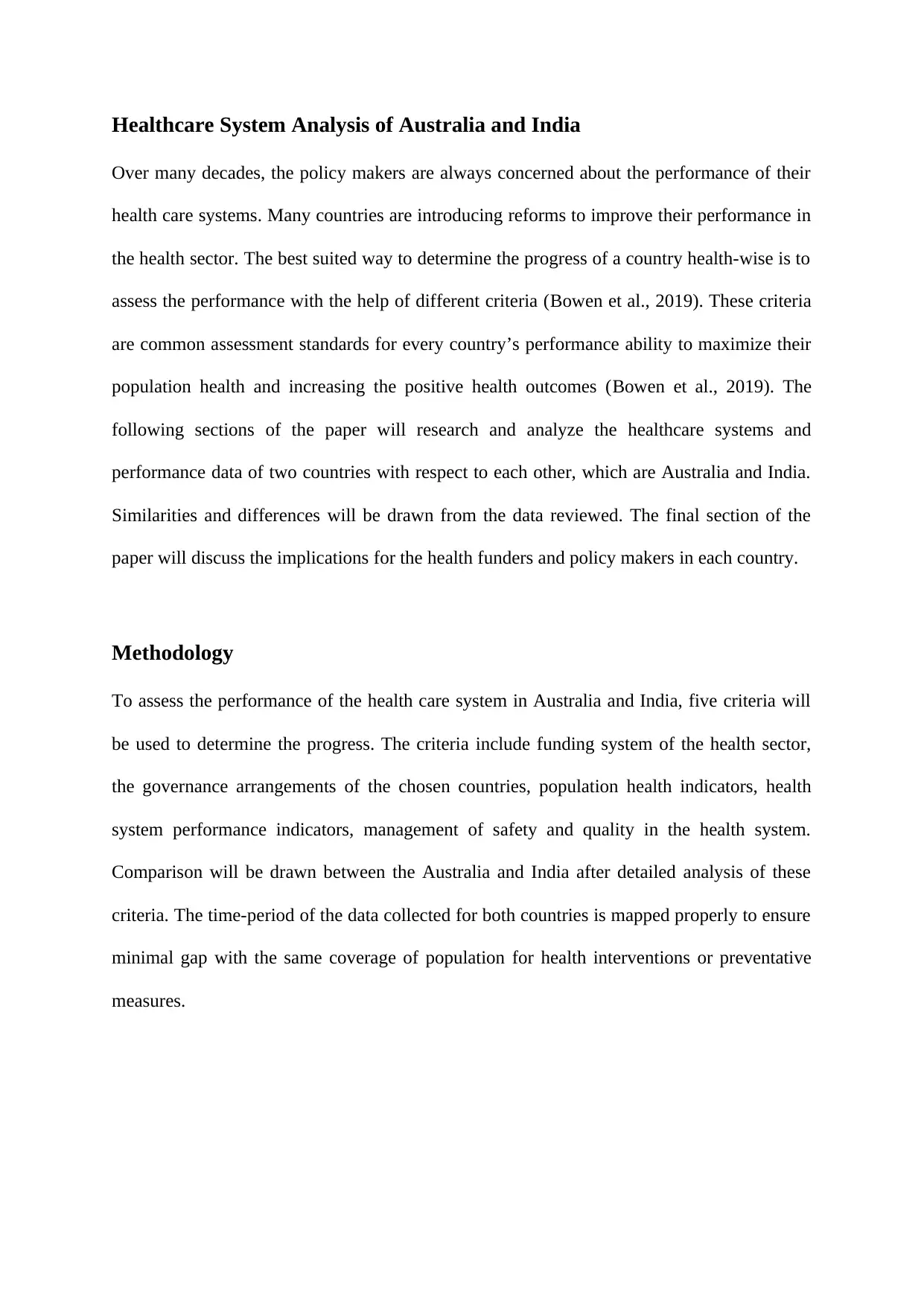
Healthcare System Analysis of Australia and India
Over many decades, the policy makers are always concerned about the performance of their
health care systems. Many countries are introducing reforms to improve their performance in
the health sector. The best suited way to determine the progress of a country health-wise is to
assess the performance with the help of different criteria (Bowen et al., 2019). These criteria
are common assessment standards for every country’s performance ability to maximize their
population health and increasing the positive health outcomes (Bowen et al., 2019). The
following sections of the paper will research and analyze the healthcare systems and
performance data of two countries with respect to each other, which are Australia and India.
Similarities and differences will be drawn from the data reviewed. The final section of the
paper will discuss the implications for the health funders and policy makers in each country.
Methodology
To assess the performance of the health care system in Australia and India, five criteria will
be used to determine the progress. The criteria include funding system of the health sector,
the governance arrangements of the chosen countries, population health indicators, health
system performance indicators, management of safety and quality in the health system.
Comparison will be drawn between the Australia and India after detailed analysis of these
criteria. The time-period of the data collected for both countries is mapped properly to ensure
minimal gap with the same coverage of population for health interventions or preventative
measures.
Over many decades, the policy makers are always concerned about the performance of their
health care systems. Many countries are introducing reforms to improve their performance in
the health sector. The best suited way to determine the progress of a country health-wise is to
assess the performance with the help of different criteria (Bowen et al., 2019). These criteria
are common assessment standards for every country’s performance ability to maximize their
population health and increasing the positive health outcomes (Bowen et al., 2019). The
following sections of the paper will research and analyze the healthcare systems and
performance data of two countries with respect to each other, which are Australia and India.
Similarities and differences will be drawn from the data reviewed. The final section of the
paper will discuss the implications for the health funders and policy makers in each country.
Methodology
To assess the performance of the health care system in Australia and India, five criteria will
be used to determine the progress. The criteria include funding system of the health sector,
the governance arrangements of the chosen countries, population health indicators, health
system performance indicators, management of safety and quality in the health system.
Comparison will be drawn between the Australia and India after detailed analysis of these
criteria. The time-period of the data collected for both countries is mapped properly to ensure
minimal gap with the same coverage of population for health interventions or preventative
measures.
Paraphrase This Document
Need a fresh take? Get an instant paraphrase of this document with our AI Paraphraser
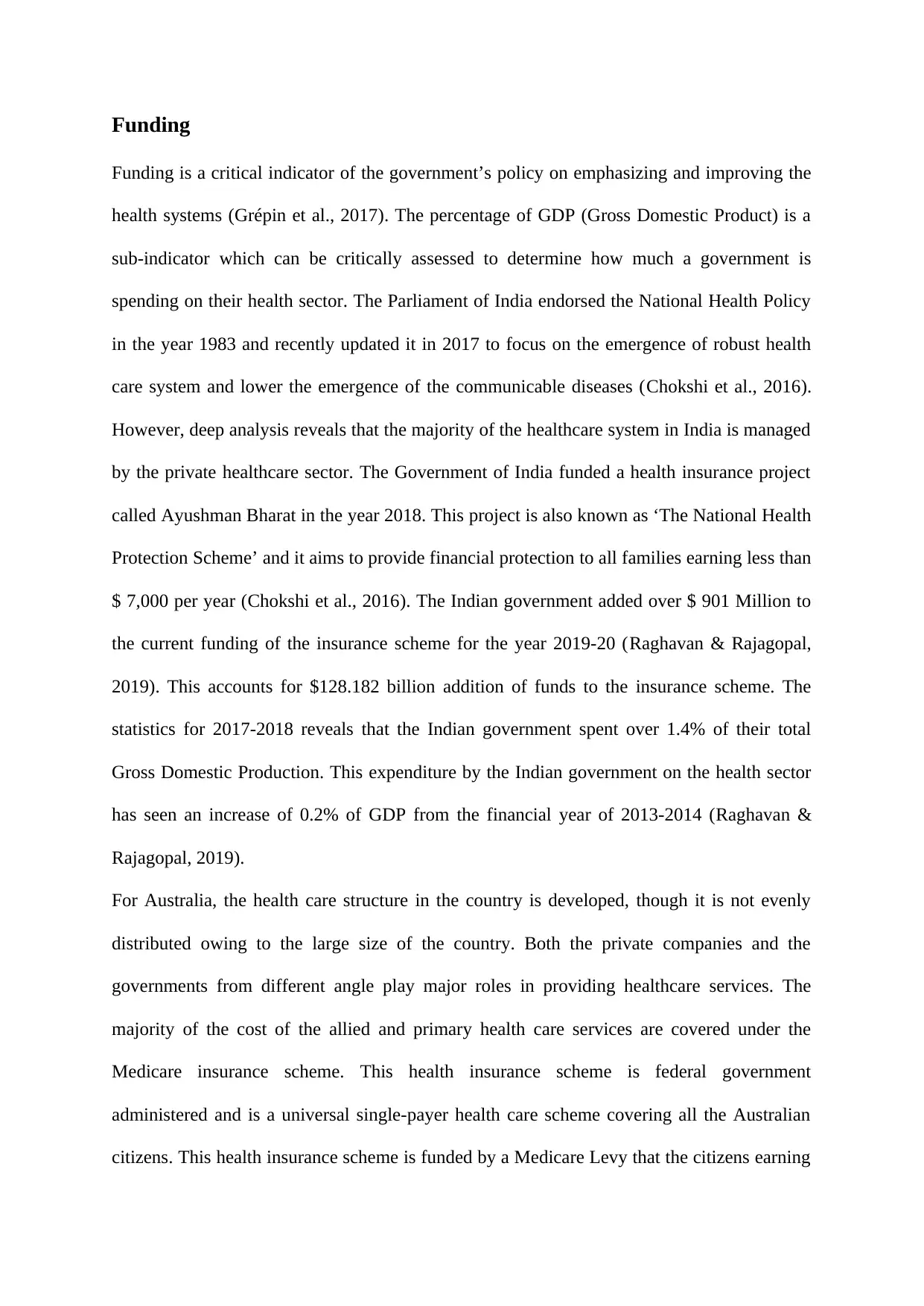
Funding
Funding is a critical indicator of the government’s policy on emphasizing and improving the
health systems (Grépin et al., 2017). The percentage of GDP (Gross Domestic Product) is a
sub-indicator which can be critically assessed to determine how much a government is
spending on their health sector. The Parliament of India endorsed the National Health Policy
in the year 1983 and recently updated it in 2017 to focus on the emergence of robust health
care system and lower the emergence of the communicable diseases (Chokshi et al., 2016).
However, deep analysis reveals that the majority of the healthcare system in India is managed
by the private healthcare sector. The Government of India funded a health insurance project
called Ayushman Bharat in the year 2018. This project is also known as ‘The National Health
Protection Scheme’ and it aims to provide financial protection to all families earning less than
$ 7,000 per year (Chokshi et al., 2016). The Indian government added over $ 901 Million to
the current funding of the insurance scheme for the year 2019-20 (Raghavan & Rajagopal,
2019). This accounts for $128.182 billion addition of funds to the insurance scheme. The
statistics for 2017-2018 reveals that the Indian government spent over 1.4% of their total
Gross Domestic Production. This expenditure by the Indian government on the health sector
has seen an increase of 0.2% of GDP from the financial year of 2013-2014 (Raghavan &
Rajagopal, 2019).
For Australia, the health care structure in the country is developed, though it is not evenly
distributed owing to the large size of the country. Both the private companies and the
governments from different angle play major roles in providing healthcare services. The
majority of the cost of the allied and primary health care services are covered under the
Medicare insurance scheme. This health insurance scheme is federal government
administered and is a universal single-payer health care scheme covering all the Australian
citizens. This health insurance scheme is funded by a Medicare Levy that the citizens earning
Funding is a critical indicator of the government’s policy on emphasizing and improving the
health systems (Grépin et al., 2017). The percentage of GDP (Gross Domestic Product) is a
sub-indicator which can be critically assessed to determine how much a government is
spending on their health sector. The Parliament of India endorsed the National Health Policy
in the year 1983 and recently updated it in 2017 to focus on the emergence of robust health
care system and lower the emergence of the communicable diseases (Chokshi et al., 2016).
However, deep analysis reveals that the majority of the healthcare system in India is managed
by the private healthcare sector. The Government of India funded a health insurance project
called Ayushman Bharat in the year 2018. This project is also known as ‘The National Health
Protection Scheme’ and it aims to provide financial protection to all families earning less than
$ 7,000 per year (Chokshi et al., 2016). The Indian government added over $ 901 Million to
the current funding of the insurance scheme for the year 2019-20 (Raghavan & Rajagopal,
2019). This accounts for $128.182 billion addition of funds to the insurance scheme. The
statistics for 2017-2018 reveals that the Indian government spent over 1.4% of their total
Gross Domestic Production. This expenditure by the Indian government on the health sector
has seen an increase of 0.2% of GDP from the financial year of 2013-2014 (Raghavan &
Rajagopal, 2019).
For Australia, the health care structure in the country is developed, though it is not evenly
distributed owing to the large size of the country. Both the private companies and the
governments from different angle play major roles in providing healthcare services. The
majority of the cost of the allied and primary health care services are covered under the
Medicare insurance scheme. This health insurance scheme is federal government
administered and is a universal single-payer health care scheme covering all the Australian
citizens. This health insurance scheme is funded by a Medicare Levy that the citizens earning
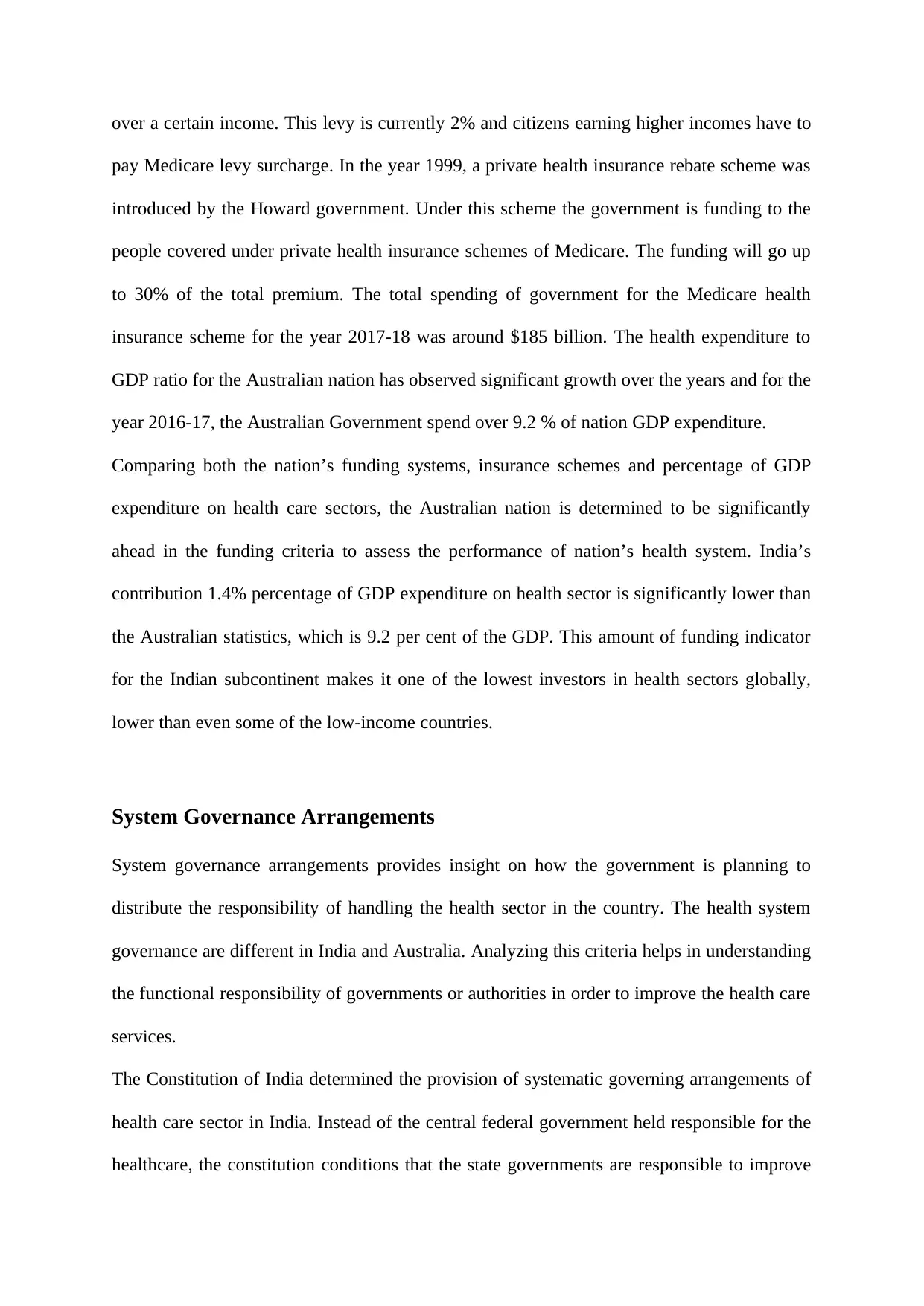
over a certain income. This levy is currently 2% and citizens earning higher incomes have to
pay Medicare levy surcharge. In the year 1999, a private health insurance rebate scheme was
introduced by the Howard government. Under this scheme the government is funding to the
people covered under private health insurance schemes of Medicare. The funding will go up
to 30% of the total premium. The total spending of government for the Medicare health
insurance scheme for the year 2017-18 was around $185 billion. The health expenditure to
GDP ratio for the Australian nation has observed significant growth over the years and for the
year 2016-17, the Australian Government spend over 9.2 % of nation GDP expenditure.
Comparing both the nation’s funding systems, insurance schemes and percentage of GDP
expenditure on health care sectors, the Australian nation is determined to be significantly
ahead in the funding criteria to assess the performance of nation’s health system. India’s
contribution 1.4% percentage of GDP expenditure on health sector is significantly lower than
the Australian statistics, which is 9.2 per cent of the GDP. This amount of funding indicator
for the Indian subcontinent makes it one of the lowest investors in health sectors globally,
lower than even some of the low-income countries.
System Governance Arrangements
System governance arrangements provides insight on how the government is planning to
distribute the responsibility of handling the health sector in the country. The health system
governance are different in India and Australia. Analyzing this criteria helps in understanding
the functional responsibility of governments or authorities in order to improve the health care
services.
The Constitution of India determined the provision of systematic governing arrangements of
health care sector in India. Instead of the central federal government held responsible for the
healthcare, the constitution conditions that the state governments are responsible to improve
pay Medicare levy surcharge. In the year 1999, a private health insurance rebate scheme was
introduced by the Howard government. Under this scheme the government is funding to the
people covered under private health insurance schemes of Medicare. The funding will go up
to 30% of the total premium. The total spending of government for the Medicare health
insurance scheme for the year 2017-18 was around $185 billion. The health expenditure to
GDP ratio for the Australian nation has observed significant growth over the years and for the
year 2016-17, the Australian Government spend over 9.2 % of nation GDP expenditure.
Comparing both the nation’s funding systems, insurance schemes and percentage of GDP
expenditure on health care sectors, the Australian nation is determined to be significantly
ahead in the funding criteria to assess the performance of nation’s health system. India’s
contribution 1.4% percentage of GDP expenditure on health sector is significantly lower than
the Australian statistics, which is 9.2 per cent of the GDP. This amount of funding indicator
for the Indian subcontinent makes it one of the lowest investors in health sectors globally,
lower than even some of the low-income countries.
System Governance Arrangements
System governance arrangements provides insight on how the government is planning to
distribute the responsibility of handling the health sector in the country. The health system
governance are different in India and Australia. Analyzing this criteria helps in understanding
the functional responsibility of governments or authorities in order to improve the health care
services.
The Constitution of India determined the provision of systematic governing arrangements of
health care sector in India. Instead of the central federal government held responsible for the
healthcare, the constitution conditions that the state governments are responsible to improve
⊘ This is a preview!⊘
Do you want full access?
Subscribe today to unlock all pages.

Trusted by 1+ million students worldwide
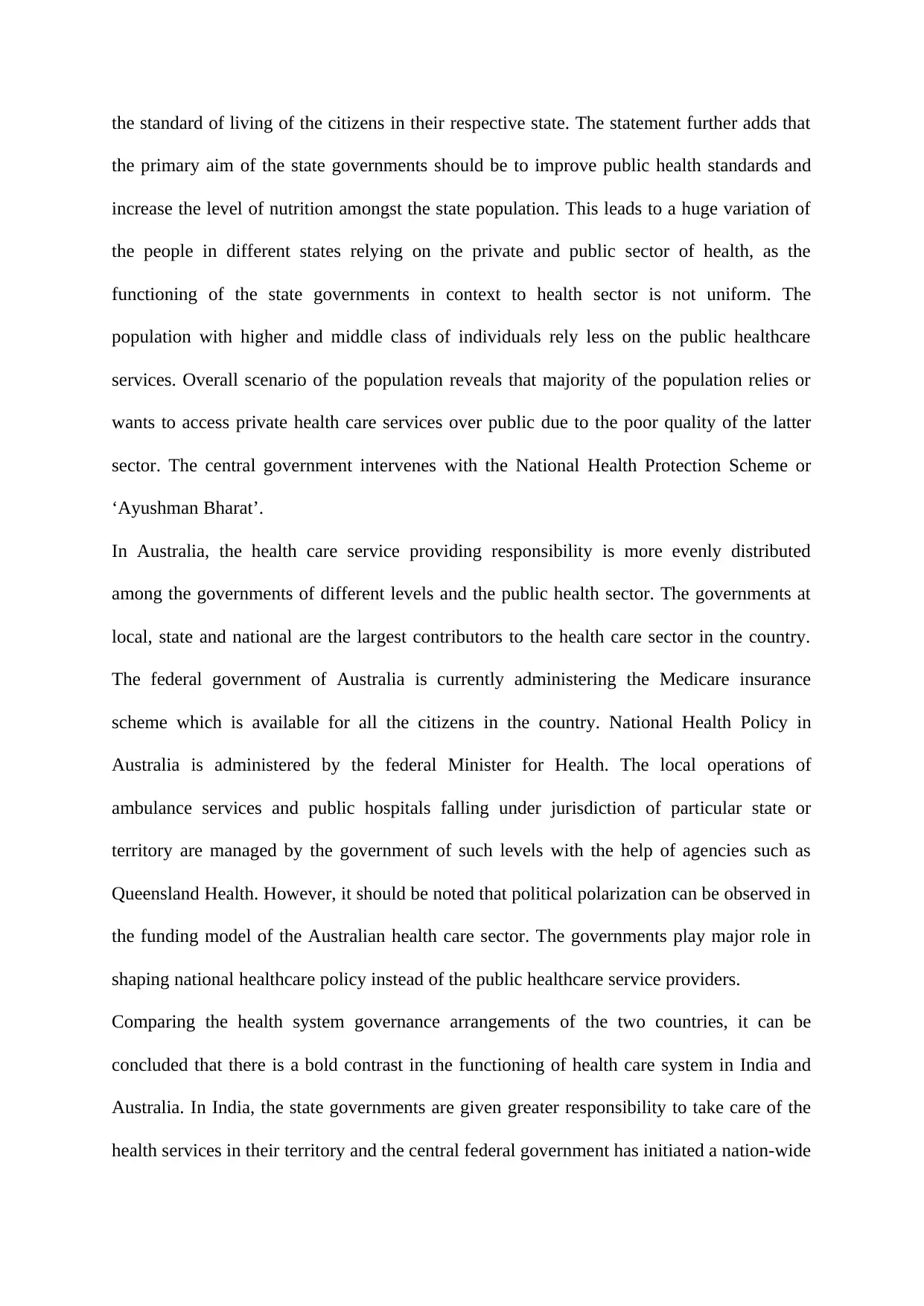
the standard of living of the citizens in their respective state. The statement further adds that
the primary aim of the state governments should be to improve public health standards and
increase the level of nutrition amongst the state population. This leads to a huge variation of
the people in different states relying on the private and public sector of health, as the
functioning of the state governments in context to health sector is not uniform. The
population with higher and middle class of individuals rely less on the public healthcare
services. Overall scenario of the population reveals that majority of the population relies or
wants to access private health care services over public due to the poor quality of the latter
sector. The central government intervenes with the National Health Protection Scheme or
‘Ayushman Bharat’.
In Australia, the health care service providing responsibility is more evenly distributed
among the governments of different levels and the public health sector. The governments at
local, state and national are the largest contributors to the health care sector in the country.
The federal government of Australia is currently administering the Medicare insurance
scheme which is available for all the citizens in the country. National Health Policy in
Australia is administered by the federal Minister for Health. The local operations of
ambulance services and public hospitals falling under jurisdiction of particular state or
territory are managed by the government of such levels with the help of agencies such as
Queensland Health. However, it should be noted that political polarization can be observed in
the funding model of the Australian health care sector. The governments play major role in
shaping national healthcare policy instead of the public healthcare service providers.
Comparing the health system governance arrangements of the two countries, it can be
concluded that there is a bold contrast in the functioning of health care system in India and
Australia. In India, the state governments are given greater responsibility to take care of the
health services in their territory and the central federal government has initiated a nation-wide
the primary aim of the state governments should be to improve public health standards and
increase the level of nutrition amongst the state population. This leads to a huge variation of
the people in different states relying on the private and public sector of health, as the
functioning of the state governments in context to health sector is not uniform. The
population with higher and middle class of individuals rely less on the public healthcare
services. Overall scenario of the population reveals that majority of the population relies or
wants to access private health care services over public due to the poor quality of the latter
sector. The central government intervenes with the National Health Protection Scheme or
‘Ayushman Bharat’.
In Australia, the health care service providing responsibility is more evenly distributed
among the governments of different levels and the public health sector. The governments at
local, state and national are the largest contributors to the health care sector in the country.
The federal government of Australia is currently administering the Medicare insurance
scheme which is available for all the citizens in the country. National Health Policy in
Australia is administered by the federal Minister for Health. The local operations of
ambulance services and public hospitals falling under jurisdiction of particular state or
territory are managed by the government of such levels with the help of agencies such as
Queensland Health. However, it should be noted that political polarization can be observed in
the funding model of the Australian health care sector. The governments play major role in
shaping national healthcare policy instead of the public healthcare service providers.
Comparing the health system governance arrangements of the two countries, it can be
concluded that there is a bold contrast in the functioning of health care system in India and
Australia. In India, the state governments are given greater responsibility to take care of the
health services in their territory and the central federal government has initiated a nation-wide
Paraphrase This Document
Need a fresh take? Get an instant paraphrase of this document with our AI Paraphraser
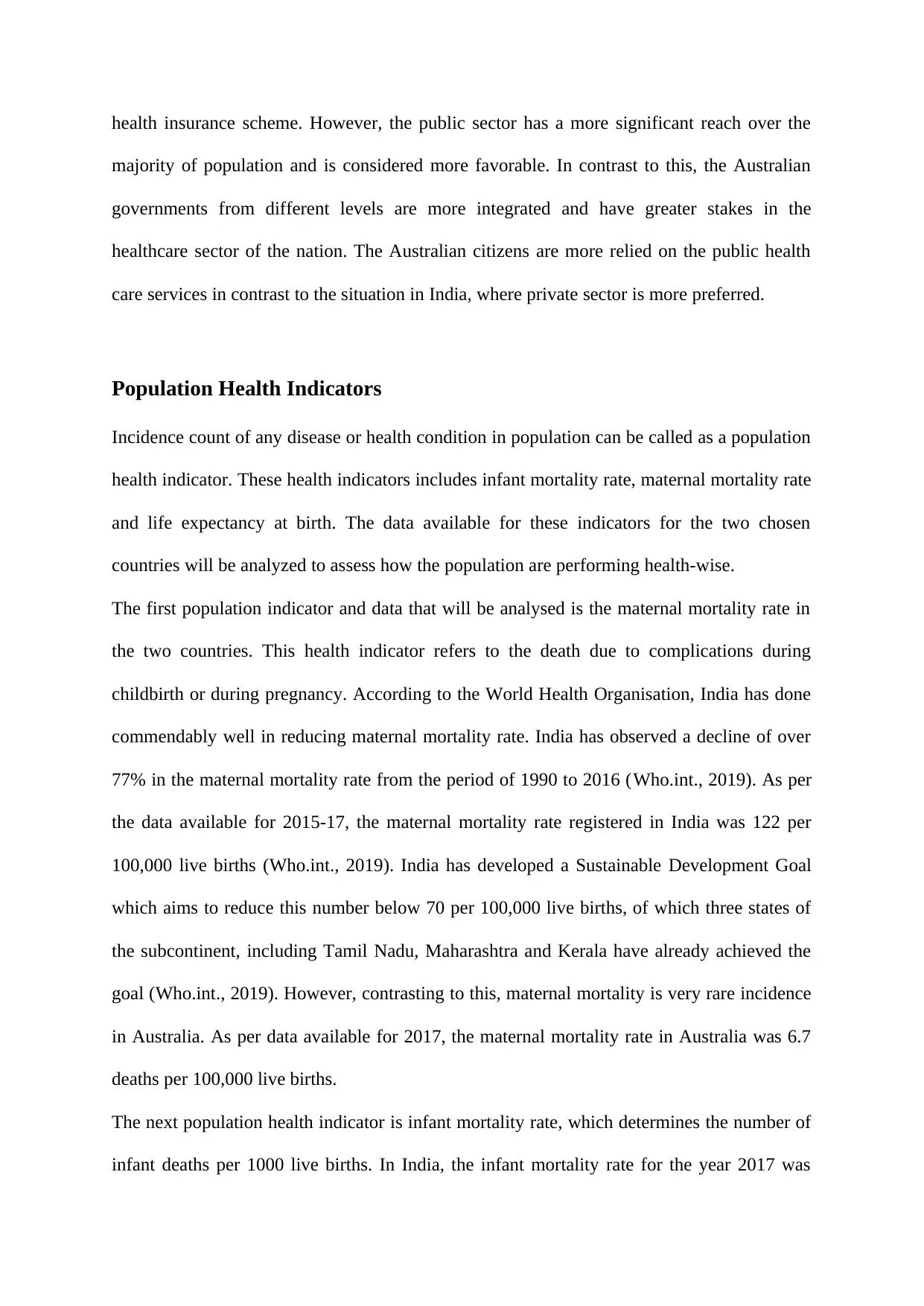
health insurance scheme. However, the public sector has a more significant reach over the
majority of population and is considered more favorable. In contrast to this, the Australian
governments from different levels are more integrated and have greater stakes in the
healthcare sector of the nation. The Australian citizens are more relied on the public health
care services in contrast to the situation in India, where private sector is more preferred.
Population Health Indicators
Incidence count of any disease or health condition in population can be called as a population
health indicator. These health indicators includes infant mortality rate, maternal mortality rate
and life expectancy at birth. The data available for these indicators for the two chosen
countries will be analyzed to assess how the population are performing health-wise.
The first population indicator and data that will be analysed is the maternal mortality rate in
the two countries. This health indicator refers to the death due to complications during
childbirth or during pregnancy. According to the World Health Organisation, India has done
commendably well in reducing maternal mortality rate. India has observed a decline of over
77% in the maternal mortality rate from the period of 1990 to 2016 (Who.int., 2019). As per
the data available for 2015-17, the maternal mortality rate registered in India was 122 per
100,000 live births (Who.int., 2019). India has developed a Sustainable Development Goal
which aims to reduce this number below 70 per 100,000 live births, of which three states of
the subcontinent, including Tamil Nadu, Maharashtra and Kerala have already achieved the
goal (Who.int., 2019). However, contrasting to this, maternal mortality is very rare incidence
in Australia. As per data available for 2017, the maternal mortality rate in Australia was 6.7
deaths per 100,000 live births.
The next population health indicator is infant mortality rate, which determines the number of
infant deaths per 1000 live births. In India, the infant mortality rate for the year 2017 was
majority of population and is considered more favorable. In contrast to this, the Australian
governments from different levels are more integrated and have greater stakes in the
healthcare sector of the nation. The Australian citizens are more relied on the public health
care services in contrast to the situation in India, where private sector is more preferred.
Population Health Indicators
Incidence count of any disease or health condition in population can be called as a population
health indicator. These health indicators includes infant mortality rate, maternal mortality rate
and life expectancy at birth. The data available for these indicators for the two chosen
countries will be analyzed to assess how the population are performing health-wise.
The first population indicator and data that will be analysed is the maternal mortality rate in
the two countries. This health indicator refers to the death due to complications during
childbirth or during pregnancy. According to the World Health Organisation, India has done
commendably well in reducing maternal mortality rate. India has observed a decline of over
77% in the maternal mortality rate from the period of 1990 to 2016 (Who.int., 2019). As per
the data available for 2015-17, the maternal mortality rate registered in India was 122 per
100,000 live births (Who.int., 2019). India has developed a Sustainable Development Goal
which aims to reduce this number below 70 per 100,000 live births, of which three states of
the subcontinent, including Tamil Nadu, Maharashtra and Kerala have already achieved the
goal (Who.int., 2019). However, contrasting to this, maternal mortality is very rare incidence
in Australia. As per data available for 2017, the maternal mortality rate in Australia was 6.7
deaths per 100,000 live births.
The next population health indicator is infant mortality rate, which determines the number of
infant deaths per 1000 live births. In India, the infant mortality rate for the year 2017 was
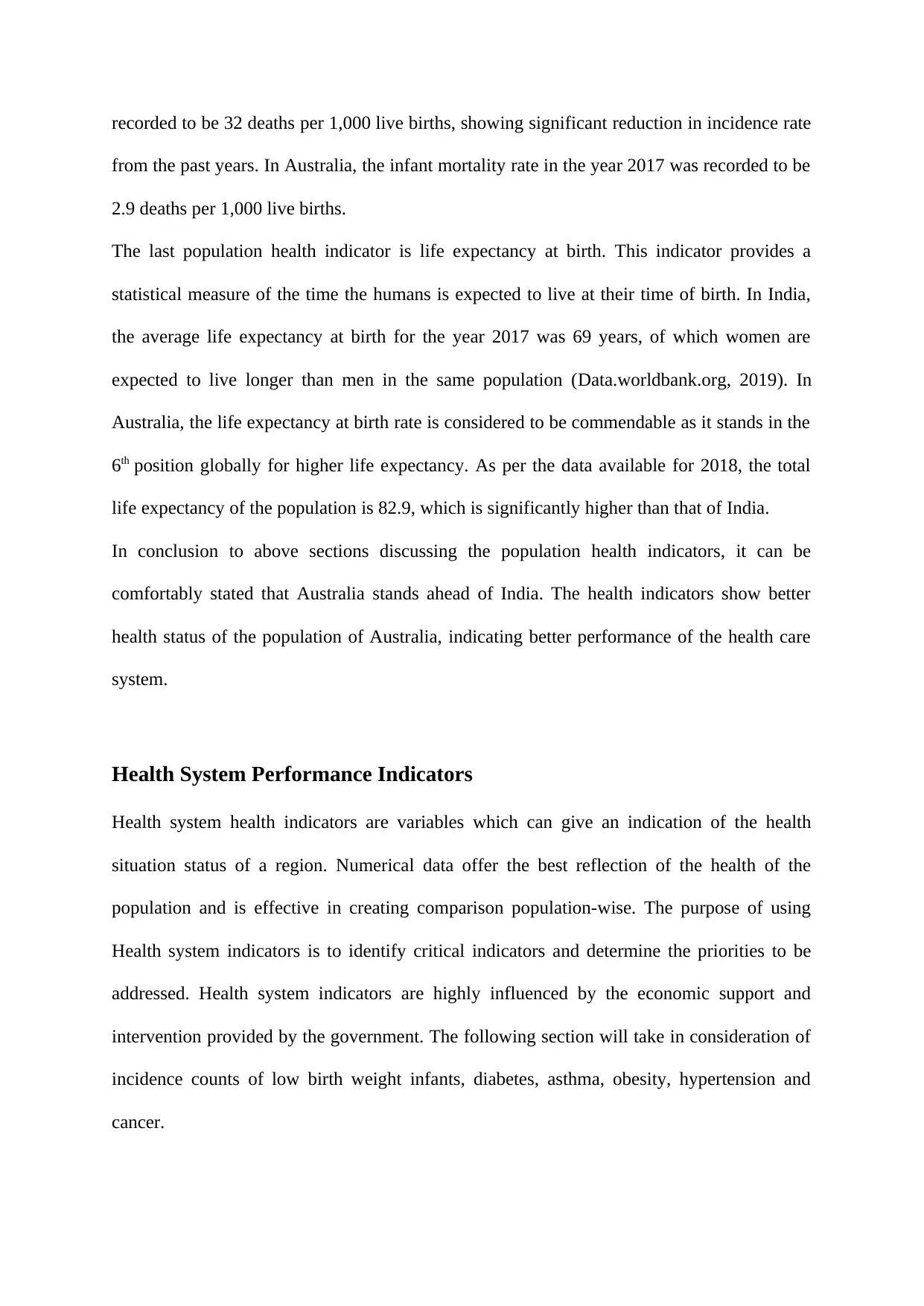
recorded to be 32 deaths per 1,000 live births, showing significant reduction in incidence rate
from the past years. In Australia, the infant mortality rate in the year 2017 was recorded to be
2.9 deaths per 1,000 live births.
The last population health indicator is life expectancy at birth. This indicator provides a
statistical measure of the time the humans is expected to live at their time of birth. In India,
the average life expectancy at birth for the year 2017 was 69 years, of which women are
expected to live longer than men in the same population (Data.worldbank.org, 2019). In
Australia, the life expectancy at birth rate is considered to be commendable as it stands in the
6th position globally for higher life expectancy. As per the data available for 2018, the total
life expectancy of the population is 82.9, which is significantly higher than that of India.
In conclusion to above sections discussing the population health indicators, it can be
comfortably stated that Australia stands ahead of India. The health indicators show better
health status of the population of Australia, indicating better performance of the health care
system.
Health System Performance Indicators
Health system health indicators are variables which can give an indication of the health
situation status of a region. Numerical data offer the best reflection of the health of the
population and is effective in creating comparison population-wise. The purpose of using
Health system indicators is to identify critical indicators and determine the priorities to be
addressed. Health system indicators are highly influenced by the economic support and
intervention provided by the government. The following section will take in consideration of
incidence counts of low birth weight infants, diabetes, asthma, obesity, hypertension and
cancer.
from the past years. In Australia, the infant mortality rate in the year 2017 was recorded to be
2.9 deaths per 1,000 live births.
The last population health indicator is life expectancy at birth. This indicator provides a
statistical measure of the time the humans is expected to live at their time of birth. In India,
the average life expectancy at birth for the year 2017 was 69 years, of which women are
expected to live longer than men in the same population (Data.worldbank.org, 2019). In
Australia, the life expectancy at birth rate is considered to be commendable as it stands in the
6th position globally for higher life expectancy. As per the data available for 2018, the total
life expectancy of the population is 82.9, which is significantly higher than that of India.
In conclusion to above sections discussing the population health indicators, it can be
comfortably stated that Australia stands ahead of India. The health indicators show better
health status of the population of Australia, indicating better performance of the health care
system.
Health System Performance Indicators
Health system health indicators are variables which can give an indication of the health
situation status of a region. Numerical data offer the best reflection of the health of the
population and is effective in creating comparison population-wise. The purpose of using
Health system indicators is to identify critical indicators and determine the priorities to be
addressed. Health system indicators are highly influenced by the economic support and
intervention provided by the government. The following section will take in consideration of
incidence counts of low birth weight infants, diabetes, asthma, obesity, hypertension and
cancer.
⊘ This is a preview!⊘
Do you want full access?
Subscribe today to unlock all pages.

Trusted by 1+ million students worldwide
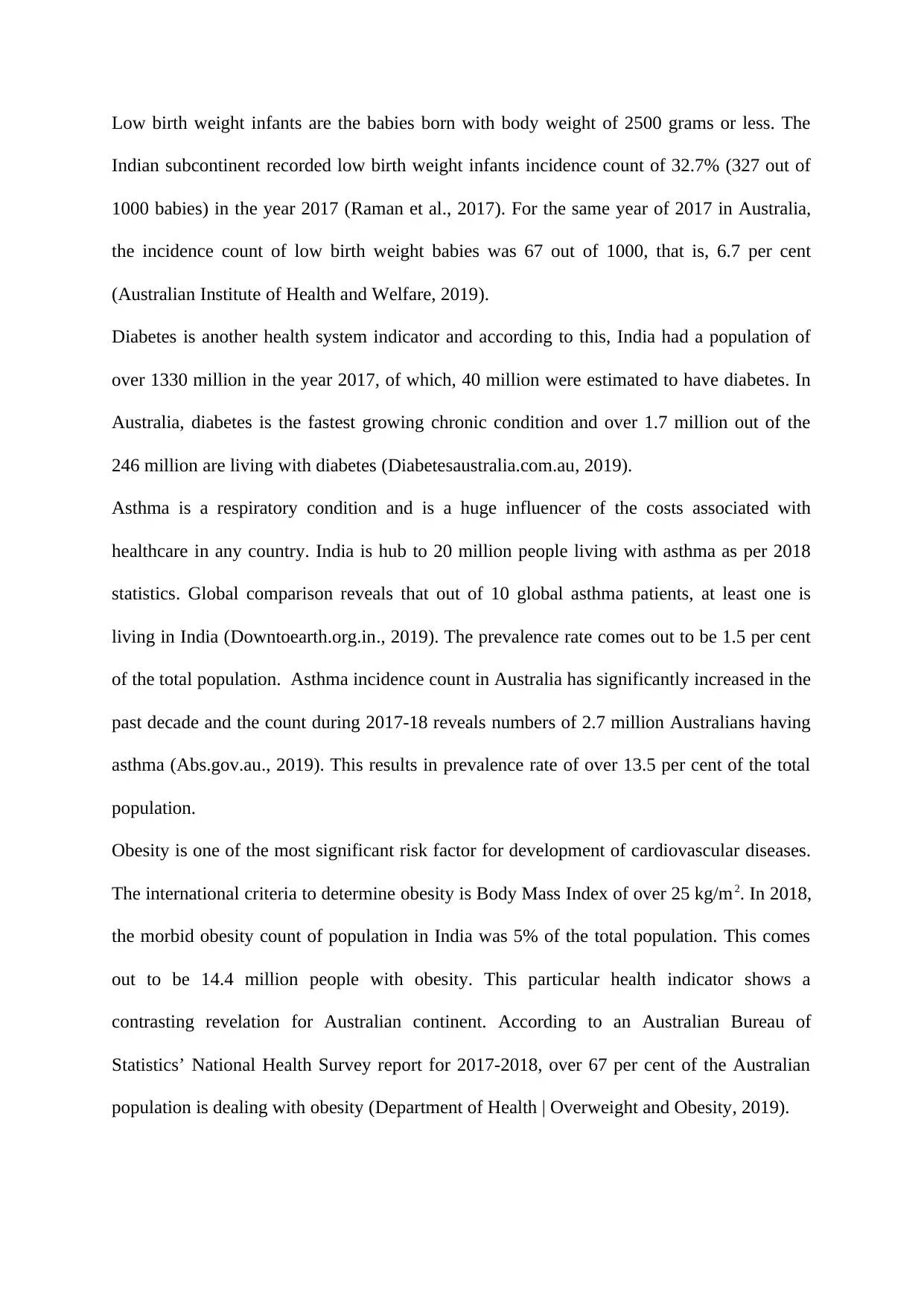
Low birth weight infants are the babies born with body weight of 2500 grams or less. The
Indian subcontinent recorded low birth weight infants incidence count of 32.7% (327 out of
1000 babies) in the year 2017 (Raman et al., 2017). For the same year of 2017 in Australia,
the incidence count of low birth weight babies was 67 out of 1000, that is, 6.7 per cent
(Australian Institute of Health and Welfare, 2019).
Diabetes is another health system indicator and according to this, India had a population of
over 1330 million in the year 2017, of which, 40 million were estimated to have diabetes. In
Australia, diabetes is the fastest growing chronic condition and over 1.7 million out of the
246 million are living with diabetes (Diabetesaustralia.com.au, 2019).
Asthma is a respiratory condition and is a huge influencer of the costs associated with
healthcare in any country. India is hub to 20 million people living with asthma as per 2018
statistics. Global comparison reveals that out of 10 global asthma patients, at least one is
living in India (Downtoearth.org.in., 2019). The prevalence rate comes out to be 1.5 per cent
of the total population. Asthma incidence count in Australia has significantly increased in the
past decade and the count during 2017-18 reveals numbers of 2.7 million Australians having
asthma (Abs.gov.au., 2019). This results in prevalence rate of over 13.5 per cent of the total
population.
Obesity is one of the most significant risk factor for development of cardiovascular diseases.
The international criteria to determine obesity is Body Mass Index of over 25 kg/m2. In 2018,
the morbid obesity count of population in India was 5% of the total population. This comes
out to be 14.4 million people with obesity. This particular health indicator shows a
contrasting revelation for Australian continent. According to an Australian Bureau of
Statistics’ National Health Survey report for 2017-2018, over 67 per cent of the Australian
population is dealing with obesity (Department of Health | Overweight and Obesity, 2019).
Indian subcontinent recorded low birth weight infants incidence count of 32.7% (327 out of
1000 babies) in the year 2017 (Raman et al., 2017). For the same year of 2017 in Australia,
the incidence count of low birth weight babies was 67 out of 1000, that is, 6.7 per cent
(Australian Institute of Health and Welfare, 2019).
Diabetes is another health system indicator and according to this, India had a population of
over 1330 million in the year 2017, of which, 40 million were estimated to have diabetes. In
Australia, diabetes is the fastest growing chronic condition and over 1.7 million out of the
246 million are living with diabetes (Diabetesaustralia.com.au, 2019).
Asthma is a respiratory condition and is a huge influencer of the costs associated with
healthcare in any country. India is hub to 20 million people living with asthma as per 2018
statistics. Global comparison reveals that out of 10 global asthma patients, at least one is
living in India (Downtoearth.org.in., 2019). The prevalence rate comes out to be 1.5 per cent
of the total population. Asthma incidence count in Australia has significantly increased in the
past decade and the count during 2017-18 reveals numbers of 2.7 million Australians having
asthma (Abs.gov.au., 2019). This results in prevalence rate of over 13.5 per cent of the total
population.
Obesity is one of the most significant risk factor for development of cardiovascular diseases.
The international criteria to determine obesity is Body Mass Index of over 25 kg/m2. In 2018,
the morbid obesity count of population in India was 5% of the total population. This comes
out to be 14.4 million people with obesity. This particular health indicator shows a
contrasting revelation for Australian continent. According to an Australian Bureau of
Statistics’ National Health Survey report for 2017-2018, over 67 per cent of the Australian
population is dealing with obesity (Department of Health | Overweight and Obesity, 2019).
Paraphrase This Document
Need a fresh take? Get an instant paraphrase of this document with our AI Paraphraser
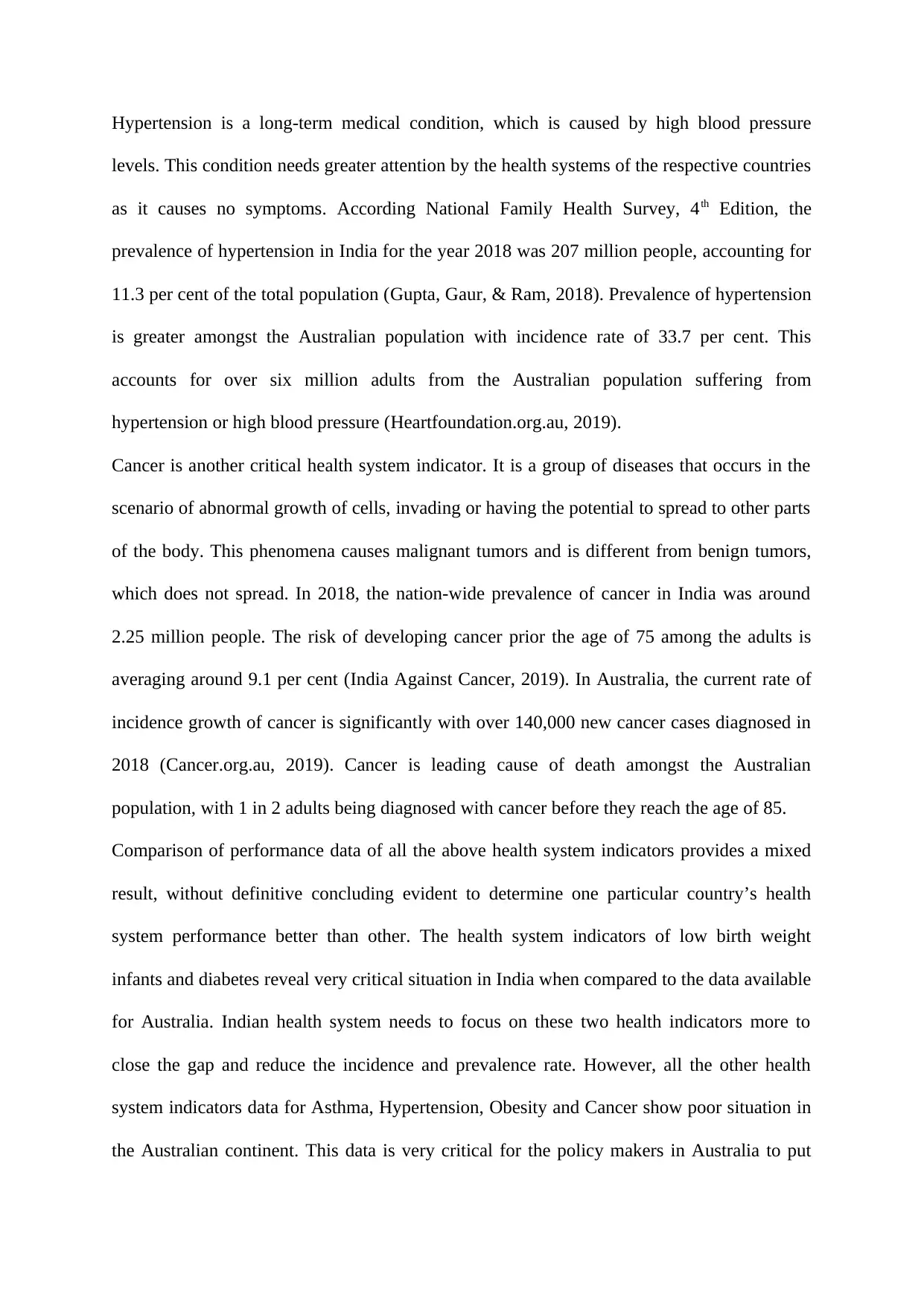
Hypertension is a long-term medical condition, which is caused by high blood pressure
levels. This condition needs greater attention by the health systems of the respective countries
as it causes no symptoms. According National Family Health Survey, 4th Edition, the
prevalence of hypertension in India for the year 2018 was 207 million people, accounting for
11.3 per cent of the total population (Gupta, Gaur, & Ram, 2018). Prevalence of hypertension
is greater amongst the Australian population with incidence rate of 33.7 per cent. This
accounts for over six million adults from the Australian population suffering from
hypertension or high blood pressure (Heartfoundation.org.au, 2019).
Cancer is another critical health system indicator. It is a group of diseases that occurs in the
scenario of abnormal growth of cells, invading or having the potential to spread to other parts
of the body. This phenomena causes malignant tumors and is different from benign tumors,
which does not spread. In 2018, the nation-wide prevalence of cancer in India was around
2.25 million people. The risk of developing cancer prior the age of 75 among the adults is
averaging around 9.1 per cent (India Against Cancer, 2019). In Australia, the current rate of
incidence growth of cancer is significantly with over 140,000 new cancer cases diagnosed in
2018 (Cancer.org.au, 2019). Cancer is leading cause of death amongst the Australian
population, with 1 in 2 adults being diagnosed with cancer before they reach the age of 85.
Comparison of performance data of all the above health system indicators provides a mixed
result, without definitive concluding evident to determine one particular country’s health
system performance better than other. The health system indicators of low birth weight
infants and diabetes reveal very critical situation in India when compared to the data available
for Australia. Indian health system needs to focus on these two health indicators more to
close the gap and reduce the incidence and prevalence rate. However, all the other health
system indicators data for Asthma, Hypertension, Obesity and Cancer show poor situation in
the Australian continent. This data is very critical for the policy makers in Australia to put
levels. This condition needs greater attention by the health systems of the respective countries
as it causes no symptoms. According National Family Health Survey, 4th Edition, the
prevalence of hypertension in India for the year 2018 was 207 million people, accounting for
11.3 per cent of the total population (Gupta, Gaur, & Ram, 2018). Prevalence of hypertension
is greater amongst the Australian population with incidence rate of 33.7 per cent. This
accounts for over six million adults from the Australian population suffering from
hypertension or high blood pressure (Heartfoundation.org.au, 2019).
Cancer is another critical health system indicator. It is a group of diseases that occurs in the
scenario of abnormal growth of cells, invading or having the potential to spread to other parts
of the body. This phenomena causes malignant tumors and is different from benign tumors,
which does not spread. In 2018, the nation-wide prevalence of cancer in India was around
2.25 million people. The risk of developing cancer prior the age of 75 among the adults is
averaging around 9.1 per cent (India Against Cancer, 2019). In Australia, the current rate of
incidence growth of cancer is significantly with over 140,000 new cancer cases diagnosed in
2018 (Cancer.org.au, 2019). Cancer is leading cause of death amongst the Australian
population, with 1 in 2 adults being diagnosed with cancer before they reach the age of 85.
Comparison of performance data of all the above health system indicators provides a mixed
result, without definitive concluding evident to determine one particular country’s health
system performance better than other. The health system indicators of low birth weight
infants and diabetes reveal very critical situation in India when compared to the data available
for Australia. Indian health system needs to focus on these two health indicators more to
close the gap and reduce the incidence and prevalence rate. However, all the other health
system indicators data for Asthma, Hypertension, Obesity and Cancer show poor situation in
the Australian continent. This data is very critical for the policy makers in Australia to put
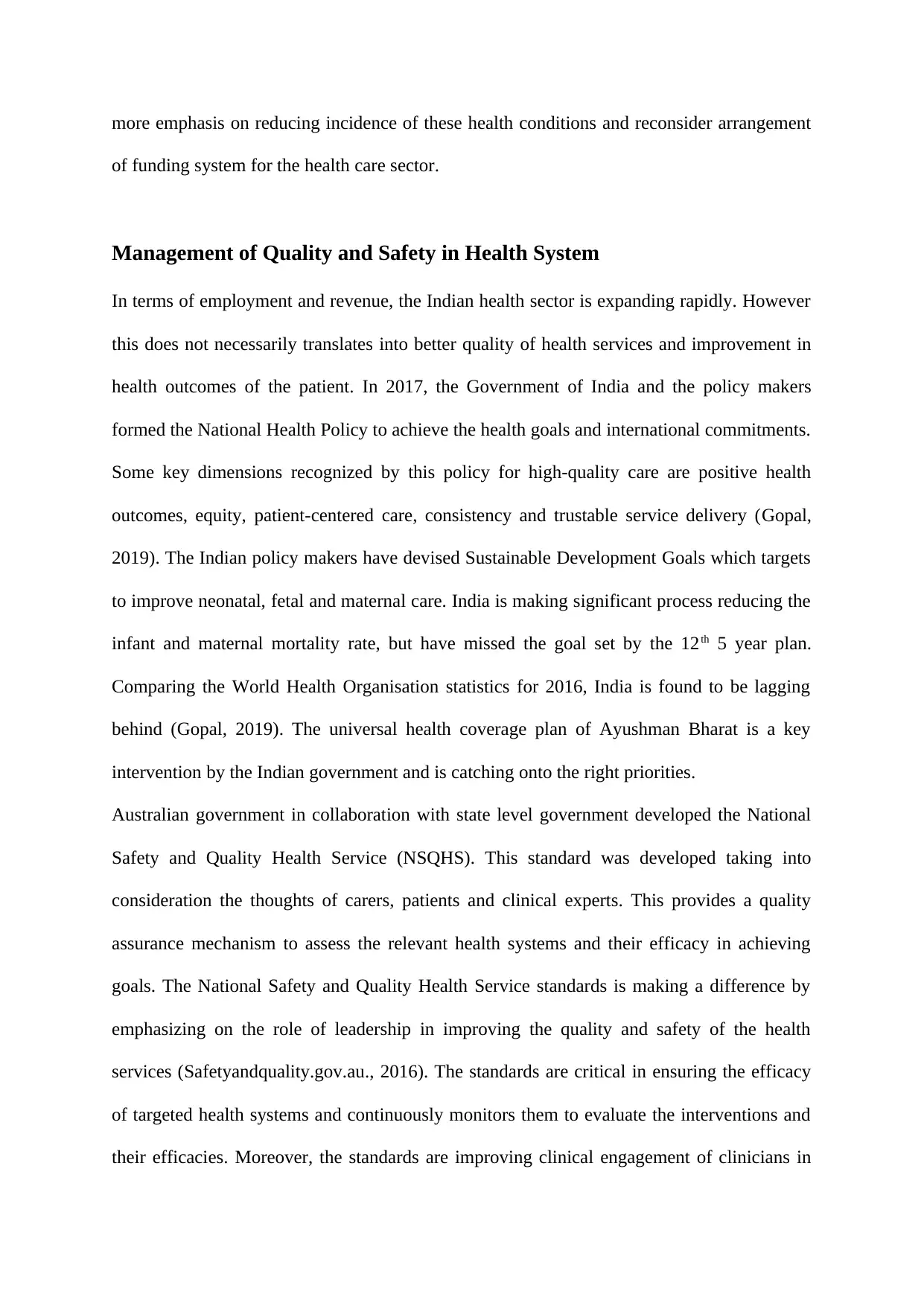
more emphasis on reducing incidence of these health conditions and reconsider arrangement
of funding system for the health care sector.
Management of Quality and Safety in Health System
In terms of employment and revenue, the Indian health sector is expanding rapidly. However
this does not necessarily translates into better quality of health services and improvement in
health outcomes of the patient. In 2017, the Government of India and the policy makers
formed the National Health Policy to achieve the health goals and international commitments.
Some key dimensions recognized by this policy for high-quality care are positive health
outcomes, equity, patient-centered care, consistency and trustable service delivery (Gopal,
2019). The Indian policy makers have devised Sustainable Development Goals which targets
to improve neonatal, fetal and maternal care. India is making significant process reducing the
infant and maternal mortality rate, but have missed the goal set by the 12th 5 year plan.
Comparing the World Health Organisation statistics for 2016, India is found to be lagging
behind (Gopal, 2019). The universal health coverage plan of Ayushman Bharat is a key
intervention by the Indian government and is catching onto the right priorities.
Australian government in collaboration with state level government developed the National
Safety and Quality Health Service (NSQHS). This standard was developed taking into
consideration the thoughts of carers, patients and clinical experts. This provides a quality
assurance mechanism to assess the relevant health systems and their efficacy in achieving
goals. The National Safety and Quality Health Service standards is making a difference by
emphasizing on the role of leadership in improving the quality and safety of the health
services (Safetyandquality.gov.au., 2016). The standards are critical in ensuring the efficacy
of targeted health systems and continuously monitors them to evaluate the interventions and
their efficacies. Moreover, the standards are improving clinical engagement of clinicians in
of funding system for the health care sector.
Management of Quality and Safety in Health System
In terms of employment and revenue, the Indian health sector is expanding rapidly. However
this does not necessarily translates into better quality of health services and improvement in
health outcomes of the patient. In 2017, the Government of India and the policy makers
formed the National Health Policy to achieve the health goals and international commitments.
Some key dimensions recognized by this policy for high-quality care are positive health
outcomes, equity, patient-centered care, consistency and trustable service delivery (Gopal,
2019). The Indian policy makers have devised Sustainable Development Goals which targets
to improve neonatal, fetal and maternal care. India is making significant process reducing the
infant and maternal mortality rate, but have missed the goal set by the 12th 5 year plan.
Comparing the World Health Organisation statistics for 2016, India is found to be lagging
behind (Gopal, 2019). The universal health coverage plan of Ayushman Bharat is a key
intervention by the Indian government and is catching onto the right priorities.
Australian government in collaboration with state level government developed the National
Safety and Quality Health Service (NSQHS). This standard was developed taking into
consideration the thoughts of carers, patients and clinical experts. This provides a quality
assurance mechanism to assess the relevant health systems and their efficacy in achieving
goals. The National Safety and Quality Health Service standards is making a difference by
emphasizing on the role of leadership in improving the quality and safety of the health
services (Safetyandquality.gov.au., 2016). The standards are critical in ensuring the efficacy
of targeted health systems and continuously monitors them to evaluate the interventions and
their efficacies. Moreover, the standards are improving clinical engagement of clinicians in
⊘ This is a preview!⊘
Do you want full access?
Subscribe today to unlock all pages.

Trusted by 1+ million students worldwide
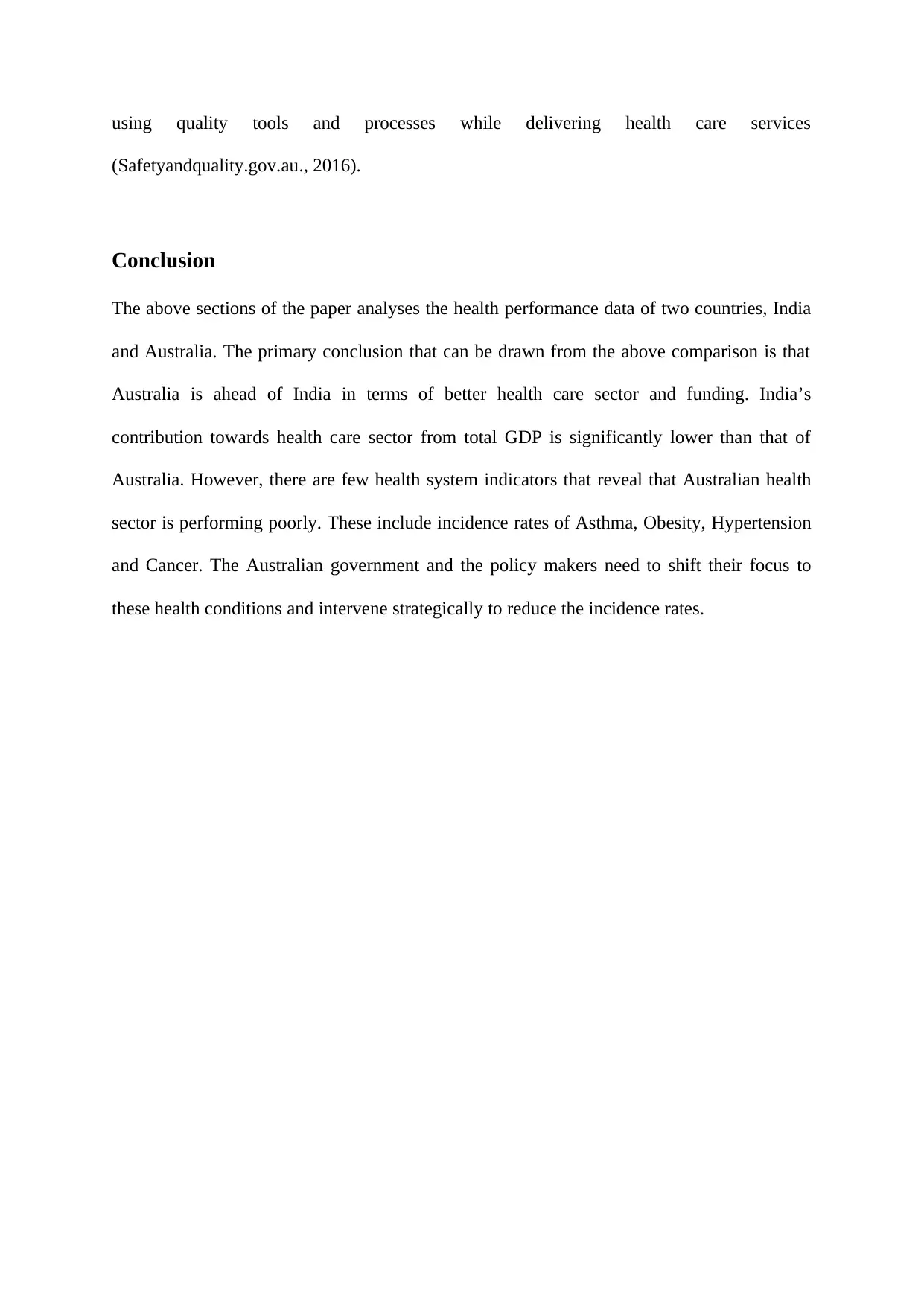
using quality tools and processes while delivering health care services
(Safetyandquality.gov.au., 2016).
Conclusion
The above sections of the paper analyses the health performance data of two countries, India
and Australia. The primary conclusion that can be drawn from the above comparison is that
Australia is ahead of India in terms of better health care sector and funding. India’s
contribution towards health care sector from total GDP is significantly lower than that of
Australia. However, there are few health system indicators that reveal that Australian health
sector is performing poorly. These include incidence rates of Asthma, Obesity, Hypertension
and Cancer. The Australian government and the policy makers need to shift their focus to
these health conditions and intervene strategically to reduce the incidence rates.
(Safetyandquality.gov.au., 2016).
Conclusion
The above sections of the paper analyses the health performance data of two countries, India
and Australia. The primary conclusion that can be drawn from the above comparison is that
Australia is ahead of India in terms of better health care sector and funding. India’s
contribution towards health care sector from total GDP is significantly lower than that of
Australia. However, there are few health system indicators that reveal that Australian health
sector is performing poorly. These include incidence rates of Asthma, Obesity, Hypertension
and Cancer. The Australian government and the policy makers need to shift their focus to
these health conditions and intervene strategically to reduce the incidence rates.
Paraphrase This Document
Need a fresh take? Get an instant paraphrase of this document with our AI Paraphraser
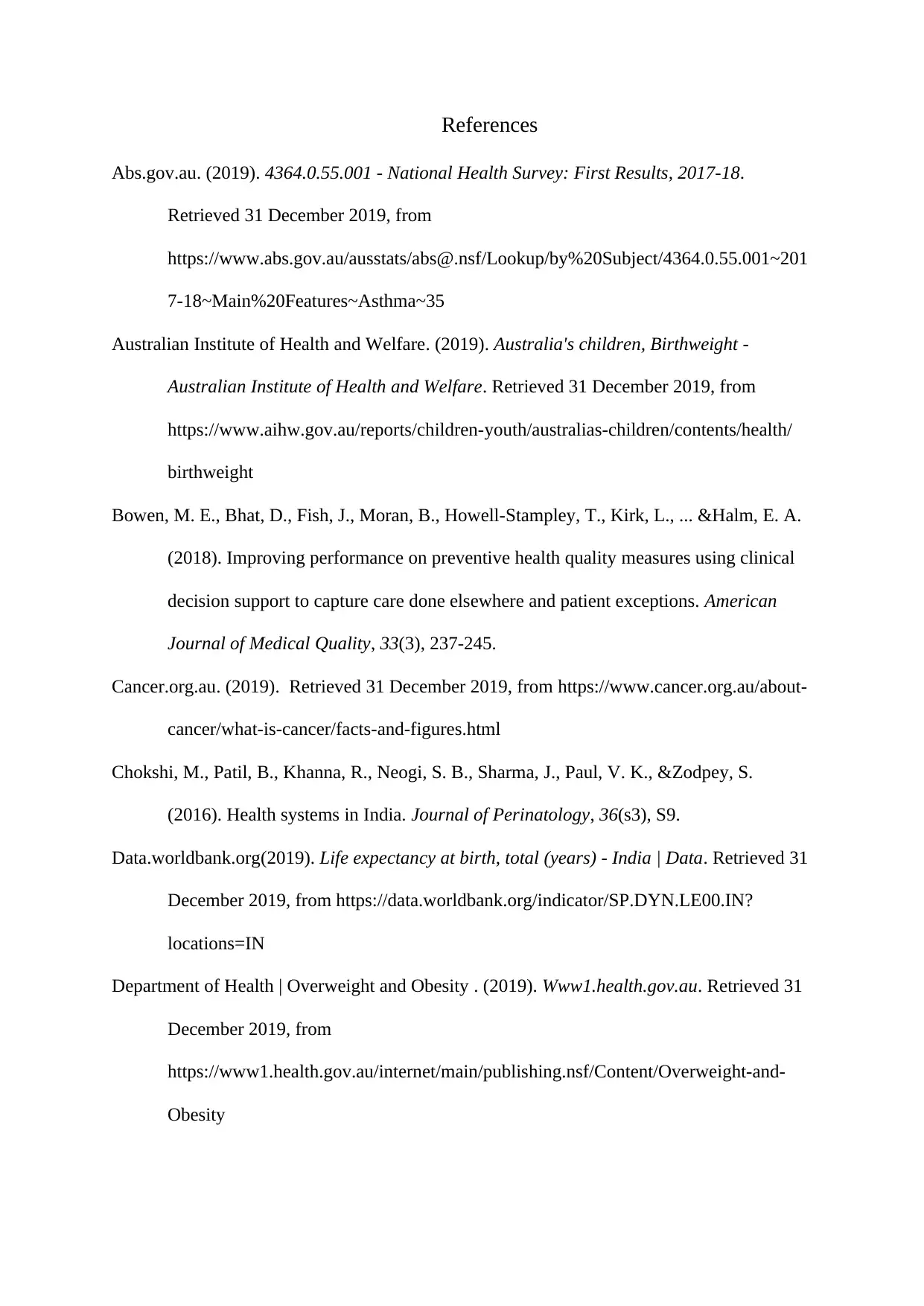
References
Abs.gov.au. (2019). 4364.0.55.001 - National Health Survey: First Results, 2017-18.
Retrieved 31 December 2019, from
https://www.abs.gov.au/ausstats/abs@.nsf/Lookup/by%20Subject/4364.0.55.001~201
7-18~Main%20Features~Asthma~35
Australian Institute of Health and Welfare. (2019). Australia's children, Birthweight -
Australian Institute of Health and Welfare. Retrieved 31 December 2019, from
https://www.aihw.gov.au/reports/children-youth/australias-children/contents/health/
birthweight
Bowen, M. E., Bhat, D., Fish, J., Moran, B., Howell-Stampley, T., Kirk, L., ... &Halm, E. A.
(2018). Improving performance on preventive health quality measures using clinical
decision support to capture care done elsewhere and patient exceptions. American
Journal of Medical Quality, 33(3), 237-245.
Cancer.org.au. (2019). Retrieved 31 December 2019, from https://www.cancer.org.au/about-
cancer/what-is-cancer/facts-and-figures.html
Chokshi, M., Patil, B., Khanna, R., Neogi, S. B., Sharma, J., Paul, V. K., &Zodpey, S.
(2016). Health systems in India. Journal of Perinatology, 36(s3), S9.
Data.worldbank.org(2019). Life expectancy at birth, total (years) - India | Data. Retrieved 31
December 2019, from https://data.worldbank.org/indicator/SP.DYN.LE00.IN?
locations=IN
Department of Health | Overweight and Obesity . (2019). Www1.health.gov.au. Retrieved 31
December 2019, from
https://www1.health.gov.au/internet/main/publishing.nsf/Content/Overweight-and-
Obesity
Abs.gov.au. (2019). 4364.0.55.001 - National Health Survey: First Results, 2017-18.
Retrieved 31 December 2019, from
https://www.abs.gov.au/ausstats/abs@.nsf/Lookup/by%20Subject/4364.0.55.001~201
7-18~Main%20Features~Asthma~35
Australian Institute of Health and Welfare. (2019). Australia's children, Birthweight -
Australian Institute of Health and Welfare. Retrieved 31 December 2019, from
https://www.aihw.gov.au/reports/children-youth/australias-children/contents/health/
birthweight
Bowen, M. E., Bhat, D., Fish, J., Moran, B., Howell-Stampley, T., Kirk, L., ... &Halm, E. A.
(2018). Improving performance on preventive health quality measures using clinical
decision support to capture care done elsewhere and patient exceptions. American
Journal of Medical Quality, 33(3), 237-245.
Cancer.org.au. (2019). Retrieved 31 December 2019, from https://www.cancer.org.au/about-
cancer/what-is-cancer/facts-and-figures.html
Chokshi, M., Patil, B., Khanna, R., Neogi, S. B., Sharma, J., Paul, V. K., &Zodpey, S.
(2016). Health systems in India. Journal of Perinatology, 36(s3), S9.
Data.worldbank.org(2019). Life expectancy at birth, total (years) - India | Data. Retrieved 31
December 2019, from https://data.worldbank.org/indicator/SP.DYN.LE00.IN?
locations=IN
Department of Health | Overweight and Obesity . (2019). Www1.health.gov.au. Retrieved 31
December 2019, from
https://www1.health.gov.au/internet/main/publishing.nsf/Content/Overweight-and-
Obesity
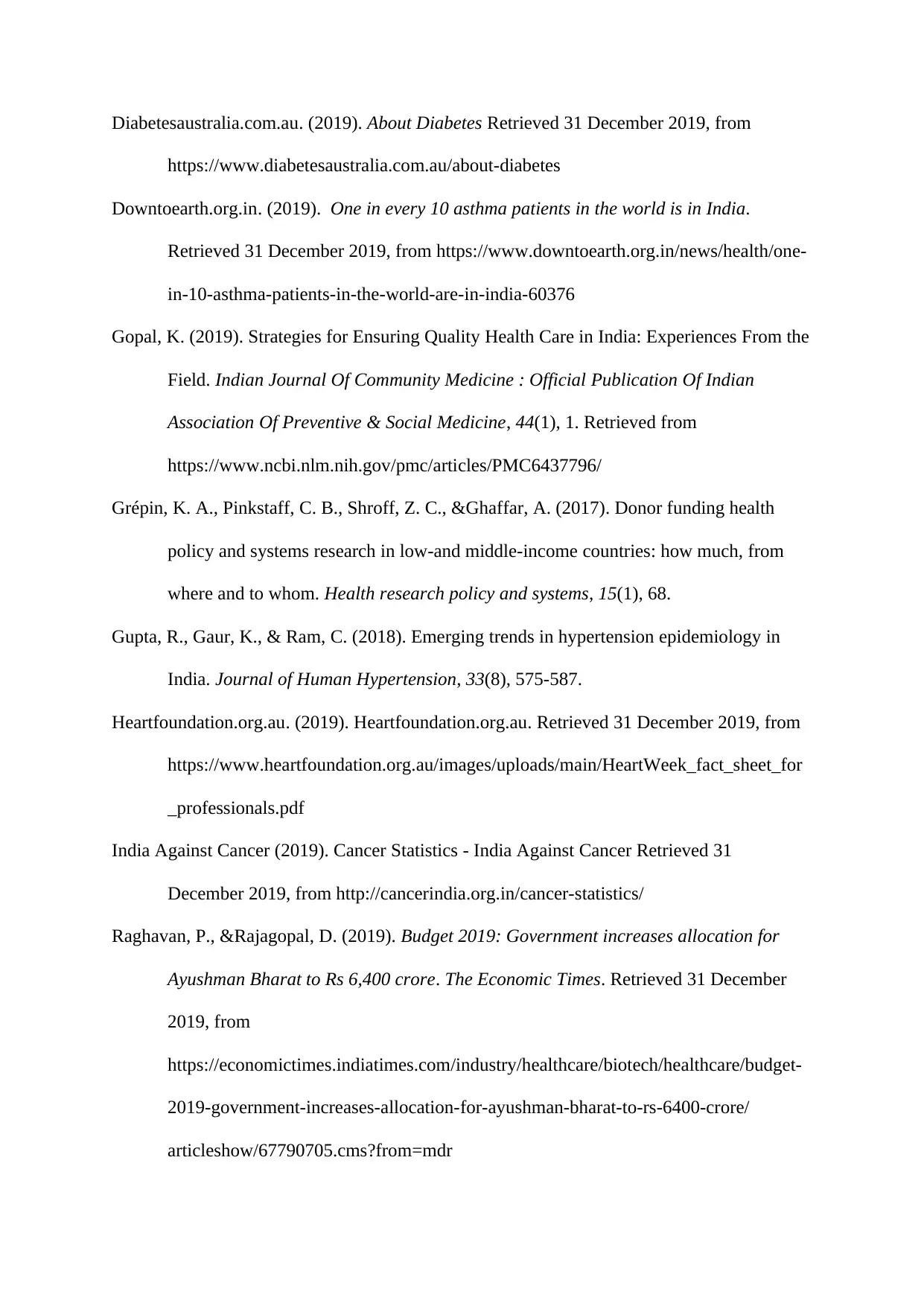
Diabetesaustralia.com.au. (2019). About Diabetes Retrieved 31 December 2019, from
https://www.diabetesaustralia.com.au/about-diabetes
Downtoearth.org.in. (2019). One in every 10 asthma patients in the world is in India.
Retrieved 31 December 2019, from https://www.downtoearth.org.in/news/health/one-
in-10-asthma-patients-in-the-world-are-in-india-60376
Gopal, K. (2019). Strategies for Ensuring Quality Health Care in India: Experiences From the
Field. Indian Journal Of Community Medicine : Official Publication Of Indian
Association Of Preventive & Social Medicine, 44(1), 1. Retrieved from
https://www.ncbi.nlm.nih.gov/pmc/articles/PMC6437796/
Grépin, K. A., Pinkstaff, C. B., Shroff, Z. C., &Ghaffar, A. (2017). Donor funding health
policy and systems research in low-and middle-income countries: how much, from
where and to whom. Health research policy and systems, 15(1), 68.
Gupta, R., Gaur, K., & Ram, C. (2018). Emerging trends in hypertension epidemiology in
India. Journal of Human Hypertension, 33(8), 575-587.
Heartfoundation.org.au. (2019). Heartfoundation.org.au. Retrieved 31 December 2019, from
https://www.heartfoundation.org.au/images/uploads/main/HeartWeek_fact_sheet_for
_professionals.pdf
India Against Cancer (2019). Cancer Statistics - India Against Cancer Retrieved 31
December 2019, from http://cancerindia.org.in/cancer-statistics/
Raghavan, P., &Rajagopal, D. (2019). Budget 2019: Government increases allocation for
Ayushman Bharat to Rs 6,400 crore. The Economic Times. Retrieved 31 December
2019, from
https://economictimes.indiatimes.com/industry/healthcare/biotech/healthcare/budget-
2019-government-increases-allocation-for-ayushman-bharat-to-rs-6400-crore/
articleshow/67790705.cms?from=mdr
https://www.diabetesaustralia.com.au/about-diabetes
Downtoearth.org.in. (2019). One in every 10 asthma patients in the world is in India.
Retrieved 31 December 2019, from https://www.downtoearth.org.in/news/health/one-
in-10-asthma-patients-in-the-world-are-in-india-60376
Gopal, K. (2019). Strategies for Ensuring Quality Health Care in India: Experiences From the
Field. Indian Journal Of Community Medicine : Official Publication Of Indian
Association Of Preventive & Social Medicine, 44(1), 1. Retrieved from
https://www.ncbi.nlm.nih.gov/pmc/articles/PMC6437796/
Grépin, K. A., Pinkstaff, C. B., Shroff, Z. C., &Ghaffar, A. (2017). Donor funding health
policy and systems research in low-and middle-income countries: how much, from
where and to whom. Health research policy and systems, 15(1), 68.
Gupta, R., Gaur, K., & Ram, C. (2018). Emerging trends in hypertension epidemiology in
India. Journal of Human Hypertension, 33(8), 575-587.
Heartfoundation.org.au. (2019). Heartfoundation.org.au. Retrieved 31 December 2019, from
https://www.heartfoundation.org.au/images/uploads/main/HeartWeek_fact_sheet_for
_professionals.pdf
India Against Cancer (2019). Cancer Statistics - India Against Cancer Retrieved 31
December 2019, from http://cancerindia.org.in/cancer-statistics/
Raghavan, P., &Rajagopal, D. (2019). Budget 2019: Government increases allocation for
Ayushman Bharat to Rs 6,400 crore. The Economic Times. Retrieved 31 December
2019, from
https://economictimes.indiatimes.com/industry/healthcare/biotech/healthcare/budget-
2019-government-increases-allocation-for-ayushman-bharat-to-rs-6400-crore/
articleshow/67790705.cms?from=mdr
⊘ This is a preview!⊘
Do you want full access?
Subscribe today to unlock all pages.

Trusted by 1+ million students worldwide
1 out of 15
Related Documents
Your All-in-One AI-Powered Toolkit for Academic Success.
+13062052269
info@desklib.com
Available 24*7 on WhatsApp / Email
![[object Object]](/_next/static/media/star-bottom.7253800d.svg)
Unlock your academic potential
Copyright © 2020–2025 A2Z Services. All Rights Reserved. Developed and managed by ZUCOL.





